

Today, a wide array of commercial-grade thermoplastics is available for prototyping and manufacturing plastic parts. Among the various materials, ABS vs PP plastic often comes up. Both are applied extensively to manufacture various products widely across industries.
Both ABS plastic and PP plastic belong to a broader category of olefin-based polymers. They, however, differ in terms of structure and performance. ABS is a blend of three distinct monomers, which gives it a unique mix of strength, rigidity, and aesthetic finish that is ideal for complex parts requiring tight tolerances. PP, on the other hand, is a homopolymer derived from propylene and is known for its toughness, flexibility, and chemical resistance, which makes it apt for lightweight, resilient applications.
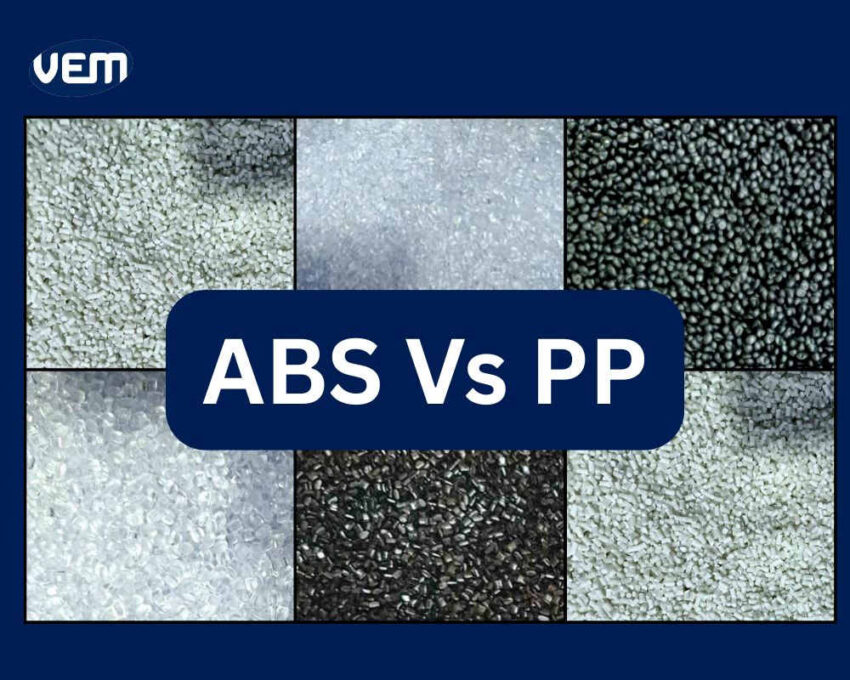
Their popularity in the manufacturing industry is also attributed to both materials being highly compatible with various manufacturing processes such as CNC machining, injection molding, and industrial-grade 3D printing, making them applicable for projects ranging from quick-turn prototypes to high-volume production runs. Thus, it’s crucial to understand when ABS plastic and PP plastic should be employed. In this article, we discuss each plastic, compare their properties, and their applications.
ABS, abbreviated for Acrylonitrile Butadiene Styrene, is an opaque and amorphous thermoplastic that consists of acrylonitrile, butadiene, and styrene monomers. ABS material also allows manufacturers to adjust the amount of each monomer to achieve a particular characteristic. For instance, increasing the acrylonitrile monomer in ABS increases the rigidity and heat stability.
ABS plastic is an extremely popular resin, and it demonstrates great dimensional stability.
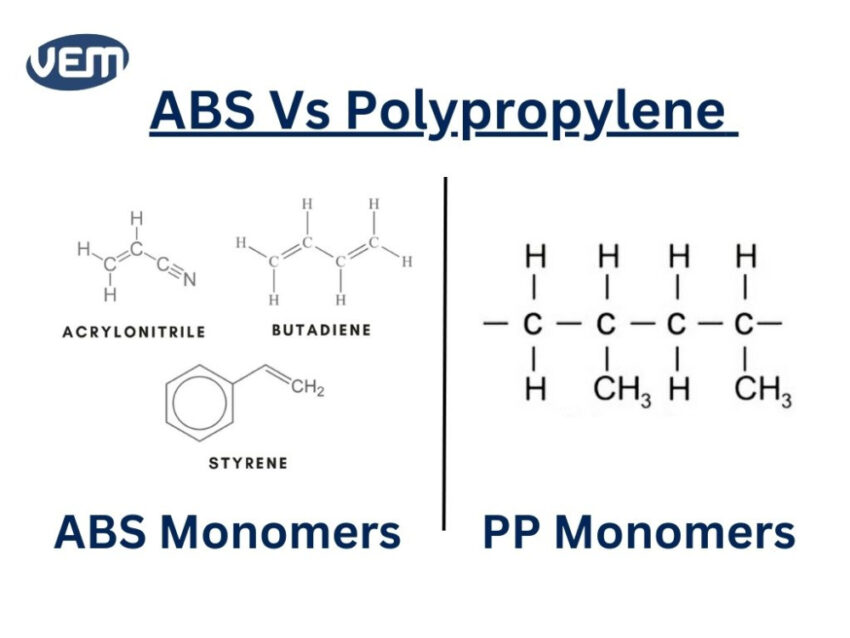
ABS is an inexpensive material. Its affordability enables manufacturers to employ it for various applications, especially when price is a priority. It’s also compatible with multiple molding processes and is an extremely versatile material for modern manufacturing.
ABS plastic is a durable material as it demonstrates slow degradation. You should note that despite being lightweight, ABS plastic maintains its aesthetics and properties even after repeated heating and heavy use. It’s thus ideal for automotive and consumer electronics applications.
ABS plastic offers an array of surface textures. It thus provides versatile finishing options that enable manufacturers to achieve aesthetic flexibility.
Plastic parts manufactured from ABS material demonstrate excellent insulation properties. Since ABS plastic parts make reliable insulators, they are popularly employed for electronic components and electrical cable insulation applications.
ABS plastic has an excellent strength-to-weight ratio, which is why it’s a popular choice for applications that require durable but lightweight components. For instance: Aerospace components.
ABS material is ductile and malleable. It thus enables manufacturers to create intricate designs, smoothening the parts and including engravings without risking defects or fracturing the part.
ABS material can withstand abrasion and mechanical stress without significant wear or damage.
ABS is heavily used in the automotive prototyping and aerospace industries because it is highly compatible with mechanical and moving parts. ABS is more ductile and malleable, meaning it can be remade into any shape without breaking apart.
ABS plastic doesn’t lose its properties upon heating, but contracts after heating. You should note that the more ABS is exposed to heat, the more it contracts.
Comparatively, ABS plastic has a lower melting temperature. It isn’t ideal for extremely high-heat applications.
ABS material is affected by UV light. Prolonged exposure to UV light leads to fading and brittleness. It stabilizes for outdoor applications only, with UV stabilizers.
ABS material is highly flammable. It produces significant fumes when it burns. Thus, it is imperative to include flame-retardant additives so that fire resistance can be enhanced.
ABS plastic is a non-biodegradable material. If it’s not correctly recycled, it can contribute to pollution of the ocean and landfills.
You can read more about ABS here.

Polypropylene, abbreviated as PP, is a low-density thermoplastic. It consists of propylene monomers and demonstrates excellent chemical resistance and water-resistant properties.
There are two types of polypropylene plastic:
PP plastic demonstrates excellent chemical resistance, such that it is resistant to most acids, bases, and solvents. It’s also highly impermeable, which makes it one of the most popular plastics when waterproof property is a priority.
Polypropylene demonstrates high strength and durability. It is thus an excellent material of choice for structural components that can withstand loads.
PP is a tough but lightweight material since it has a low density. This makes PP an ideal raw material for making lightweight parts that are also tough.
PP is moldable and thus allows flexibility to manufacturers for creating an array of products.
PP has an extremely low melting point, due to which the material melts even at the slightest exposure to intense heat. It’s also highly susceptible to combustion when exposed to high temperatures or open flames due to its low melting point.
Polypropylene doesn’t work well with adhesives as it has poor bonding properties, which is why adhesives or paint can’t adhere to its surface. You can use special surface treatments and adhesive formulations, but they increase the production cost.
Polypropylene is a non-biodegradable material. PP plastic recycling must be carried out correctly so that it does not contribute to pollution in the environment.
You can read more about PP here.
ABS plastic and Polypropylene plastic are some of the most popular resins that are employed for manufacturing high-quality plastic parts. In this section, we compare their mechanical, chemical, and thermal properties.
Mechanical properties such as tensile strength, flexural modulus, and impact resistance directly influence the performance and durability of plastic parts.
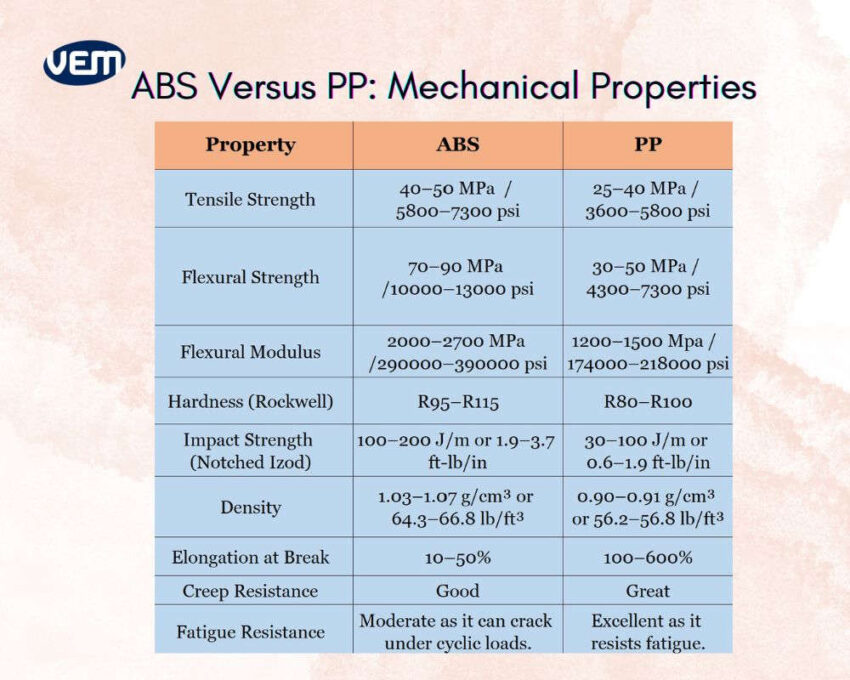
ABS plastic is known for its high tensile strength and stiffness, which is why it’s ideal for parts that need to hold their shape under mechanical load. It also demonstrates excellent impact resistance, which helps it to withstand shocks. PP, on the other hand, has a lower tensile strength and is more flexible, but it excels in fatigue resistance and elongation at break, which allows it to be flexible and bendable.
PP plastic doesn’t match ABS in terms of rigidity, but it excels in toughness under continuous stress. ABS’s higher hardness enhances the aesthetics by giving it a smoother, scratch-resistant surface, while PP plastic’s softer surface is better suited for parts that need cushioning or contact with other surfaces.
ABS vs PP in chemical properties is interesting, as they determining how and where the plastic part can be used without degradation. In this case, Polypropylene plastic performs better than ABS material as it demonstrates excellent resistance to acids, bases, and solvents, which makes it a preferred choice for parts when exposed to aggressive chemicals. ABS plastic, on the other hand, is better suited for drier environments where aesthetic quality and rigidity matter more than chemical durability.
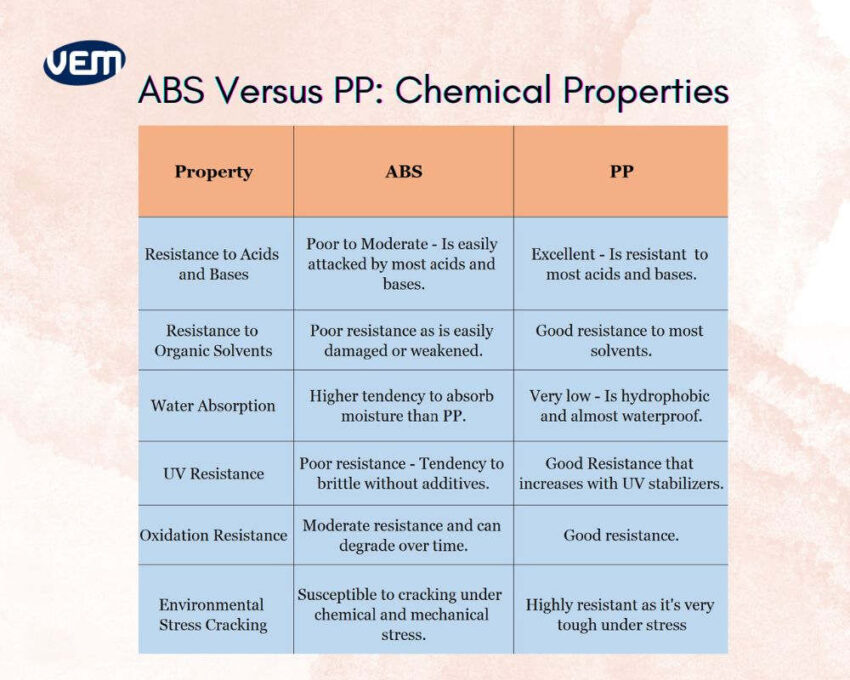
The next key factor in chemical properties is water absorption. ABS material absorbs more moisture and can influence pre-molding conditions, which is why it must be dried before processing. PP plastic, on the other hand, is hydrophobic and is thus ideal for waterproof and other outdoor components.
In a manufacturing setting, the chemical stability of PP plastic allows it to endure harsher conditions, but requires more attention for shrinkage and molding precision, whereas ABS material is chemically sensitive, but offers better control in aesthetic detailing.
Thermal properties directly affect how a particular plastic behaves during molding and in its final environmental conditions. ABS plastic has a higher glass transition temperature of approximately 105°C / 221°F, which enables it to maintain its rigidity and dimensional accuracy under moderate heat temperatures. In addition, ABS material doesn’t demonstrate a true melting point due to its amorphous nature, which enables a consistent flow and surface finish during the molding process. PP plastic, on the other hand, has a lower glass transition temperature and a defined melting point of between 130°C to 171°C /266°F to 340°F.
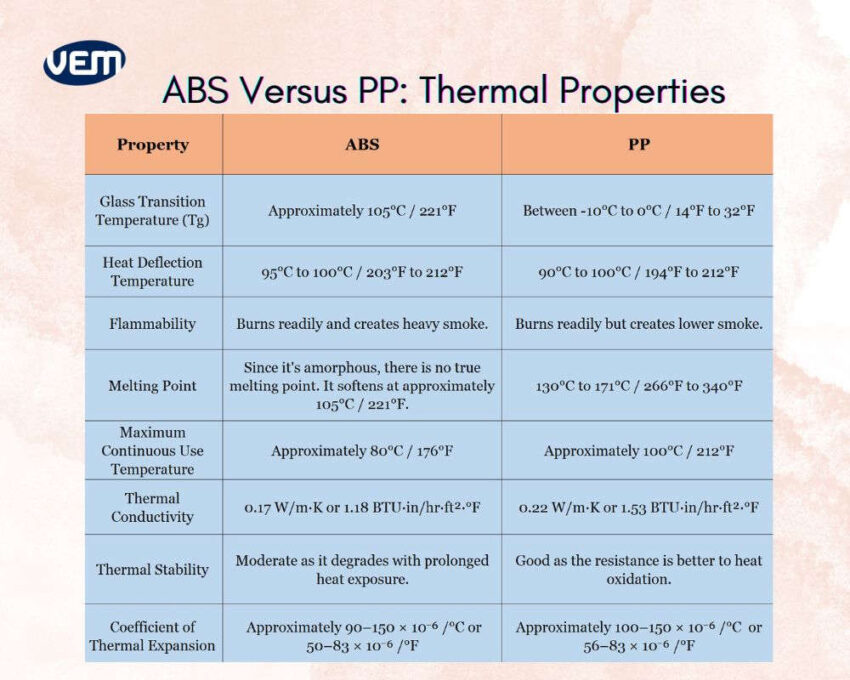
Heat deflection temperature indicates how the molded parts perform under mechanical stress. Both have similar heat deflection temperatures, but PP plastic performs better under continuous heat exposure due to its semi-crystalline structure.
Thermal conductivity and coefficient of thermal expansion indicate how the material cools and shrinks within the mold. Since ABS plastic is amorphous, it cools more uniformly, thereby allowing for tighter tolerances, whereas PP plastic may need to be compensated in tool design to manage shrinkage.
Both ABS material and PP plastic have a wide range of applications in various industries. Let’s understand when ABS and Propylene are employed in some of the most popular industries in this section:
ABS material and PP plastic are widely applied in automotive applications. They are, however, chosen strategically, which is typically based on the required functions and aesthetics.
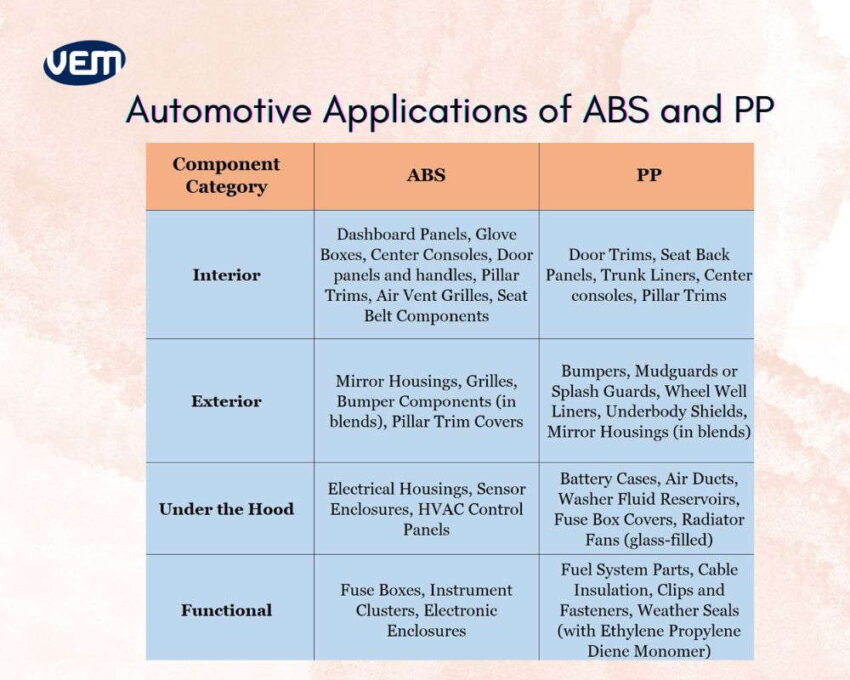
In automotive interior applications, ABS material is often selected for visible components such as dashboard panels, glove boxes, and center consoles due to its rigidity, excellent surface finish, and ability to be colored and textured. It offers superior dimensional stability and impact resistance, thus making it ideal for parts that require tight tolerances and a polished look, such as door handles, pillar trims, and air vent grilles. In addition, ABS plastic maintains its shape well under moderate heat, which is valuable when parts are exposed to sunlight or fluctuating temperatures. On the other hand, PP material is employed when flexibility and chemical resistance are a priority. It’s especially employed for parts that are hidden or need to be lightweight and resilient, such as carpet backings, seat back panels, and trunk liners.
On the exterior, ABS blends are employed where impact resistance and cosmetic appeal are essential, such as mirror housing and grilles. PP plastic is favored for high-impact, or flexible exterior parts such as bumpers or mudguards, due to its lightweight nature and its ability to flex without cracking.
ABS material is also applied for under-the-hood and functional applications that demand electrical insulation, precision molding, and moderate heat tolerance, such as sensor enclosures, HVAC control panels, and electrical housings, due to its dimensional stability and rigidity. PP plastic is especially employed in under-the-hood and functional applications, in chemically exposed environments such as battery casings, air ducts, washer fluid reservoirs, fuel system parts, etc.
In medical applications, ABS material is particularly selected for its durability, strength, and design flexibility, whereas PP plastic is selected for its chemical stability and sterilization compatibility.
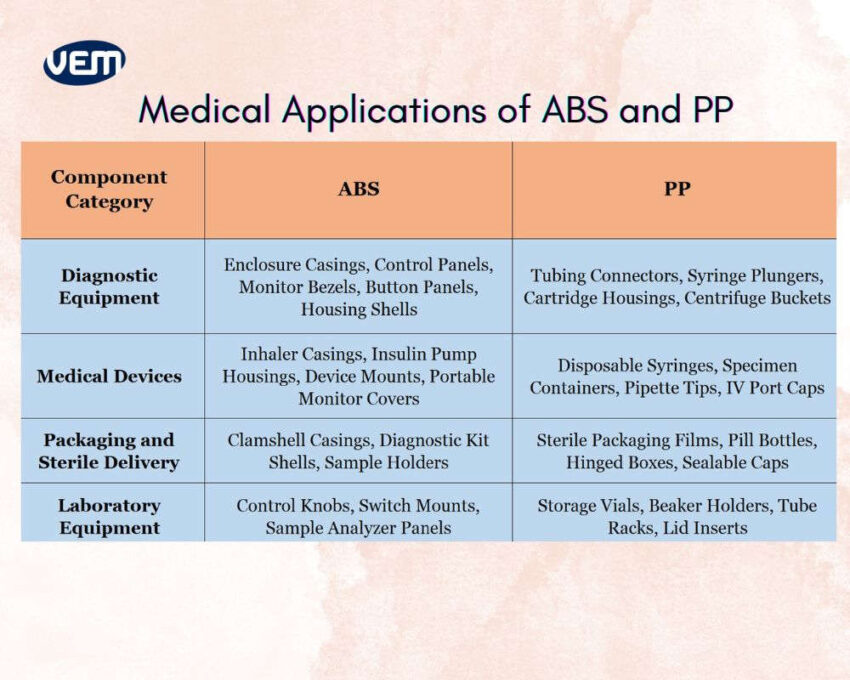
ABS material is employed in diagnostic equipment for manufacturing structural and visible components such as enclosure casings, monitor bezels, control panels, etc, whereas PP plastic is applied in more functional roles, such as tubing connectors, syringe plungers, centrifuge buckets, etc.
For disposable medical devices, PP plastic is preferred due to its low cost, biocompatibility, and resistance to heat and chemicals. It is thus applied in manufacturing medical devices that are especially used for single-use hygiene purposes and need to be safely discarded after contact with biological materials such as syringes, pipette tips, specimen containers, and IV port caps. ABS material, on the other hand, is employed when long-term durability and mechanical integrity are essential, such as inhaler casings and insulin pump shells. In addition, ABS is also employed to support high-precision components such as device mounts that need to encase sensors or electronics.
In the case of laboratory instruments, ABS is used in manufacturing where its toughness, aesthetics, and ease of manufacturing are a priority, such as bed remote controls and switch covers. PP, on the other hand, is applied for manufacturing lightweight parts, where resistance to repeated cleaning with harsh disinfectants is a priority, such as drawer trays, beaker holders, and vial racks.
ABS material and PP Plastic together enable aerospace manufacturers to balance safety, performance, and weight with cost-effective manufacturing.
ABS is widely employed in cabin interiors that require an attractive finish, precision, and durability. Its ability to be molded into complex shapes with tight tolerances makes it ideal for manufacturing tray tables, seat backs, and air vent panels, etc. whereas, PP plastic is employed in manufacturing less visible but critical parts where light-weightedness, flexibility, and resistance to cleaning chemicals are crucial, such as trim panels and armrest inserts.
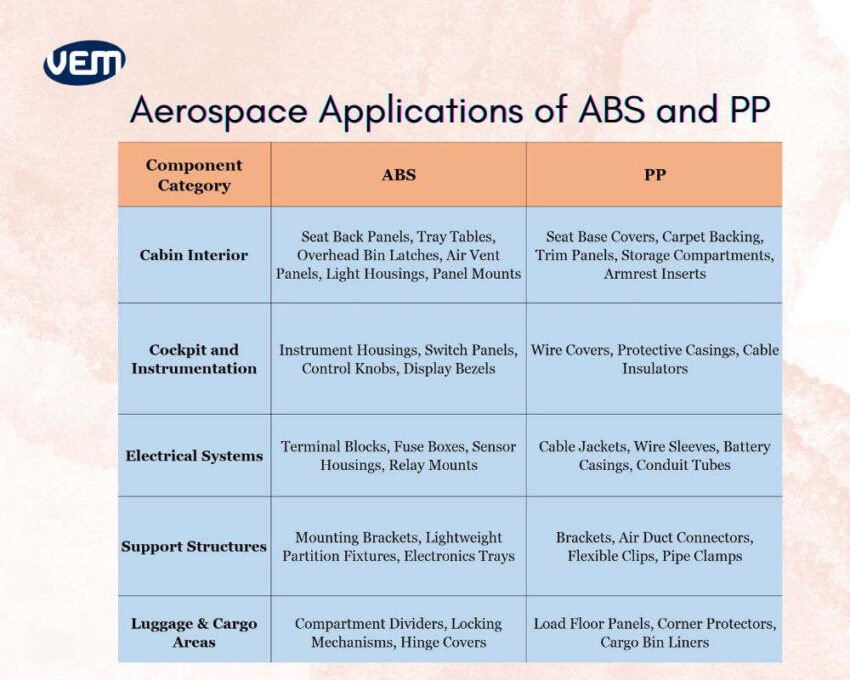
In cockpit and instrumentation systems, ABS is employed for its mechanical strength to manufacture instrument housings, switch panels, display bezels, and control knobs whereas PP plastic is employed for its flexibility, electrical insulation and chemical resistance properties to manufacture wire covers, protective casings, and cable insulators.
ABS material and PP plastic serve niche roles in the support structures, luggage, and cargo areas as well. ABS is an effective alternative where moderate strength and dimensional stability are a priority, which is why it is applied for manufacturing mounting brackets, lightweight partitions, and electronic trays. PP plastic, due to its flexibility and toughness, is applied in areas where repeated mechanical stress and exposure to rough handling occur, such as duct connectors, pipe clamps, and cargo bin liners. PP plastic’s resistance to moisture and chemicals makes it an ideal material for load floor panels and corner protectors that endure heavy wear without corroding or cracking.
ABS material is a go-to material for home appliances where aesthetics, strength, and dimensional precision are a priority, such as mixer housings, vacuum cleaner shells, and fan guards. These components of home appliances are often visible and undergo frequent handling. PP plastic is employed when lightweight, flexibility, and chemical resistance are a priority over aesthetics, such as food processor bowls and washing machine paddles. They benefit from PP plastic’s durability under mechanical stress, exposure to detergents, and even hot water.
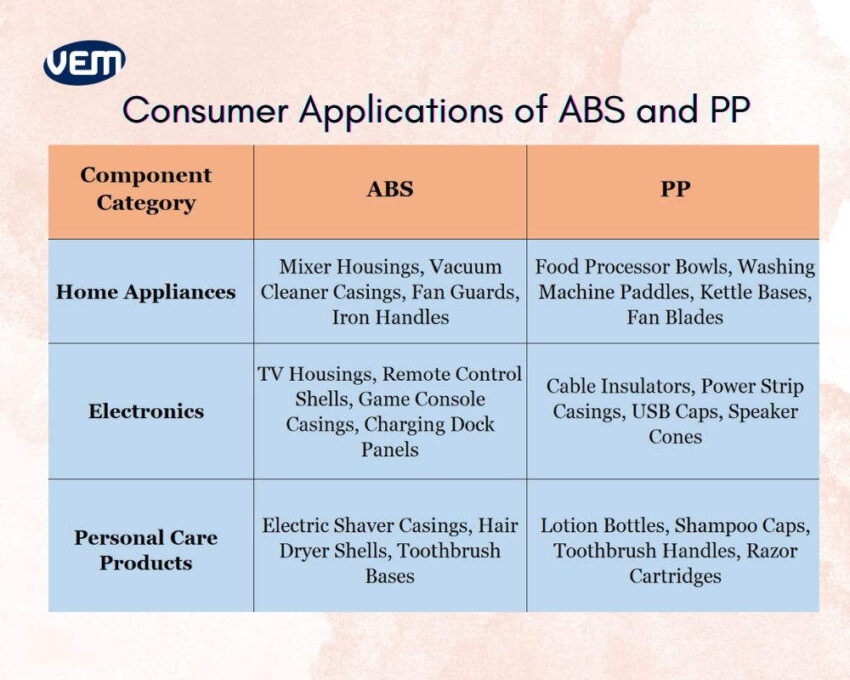
When it comes to electronics and gadgets, ABS material is a popular resin for manufacturing TV casings, remote control shells, game consoles, etc., due to its rigidity, insulating properties, tight tolerances, and polished appearances. In contrast, PP plastic is widely employed for manufacturing accessories such as USB caps, power strip casings, and speaker cones, due to its cost, flexibility, and heat resistance. Since it demonstrates chemical stability and fatigue resistance, it’s a popular material for parts that bend or twist.
In personal care products, ABS material is popularly applied to manufacture electric shaver bodies, hair dryer shells, and rechargeable toothbrush bases, as it offers a high-quality feel that matches consumer expectations for durability and design whereas PP is applied to manufacture more functional or disposable items such as shampoo caps, lotion bottles, razor cartridges, etc. where cost-effectiveness and moisture resistance are vital.
Choosing between ABS material and PP plastic largely depends on the aesthetics and the functionality of the part. While these resins seem similar at first glance, they are distinct from each other in terms of properties and thus have very specific applications. In some cases, cost isn’t the primary factor. It’s about selecting the most apt material for the part such that it enhances the performance, durability, and design of your final product.
VEM-Tooling has over 20 years of experience in mold building and manufacturing high-quality plastic parts. Our design experts and experienced engineers can help you understand which material is apt for your part and other manufacturing solutions.
To provide the best experiences, we use technologies like cookies to store and/or access device information. Consenting to these technologies will allow us to process data such as browsing behavior or unique IDs on this site. Not consenting or withdrawing consent, may adversely affect certain features and functions.